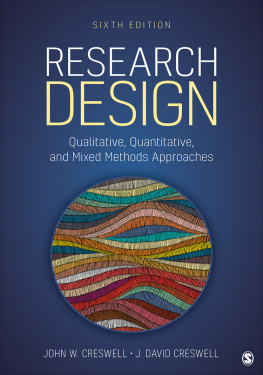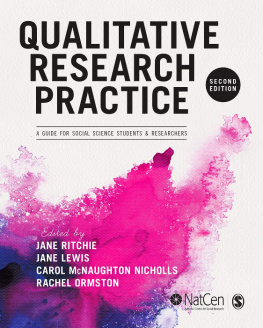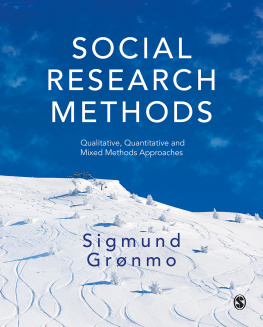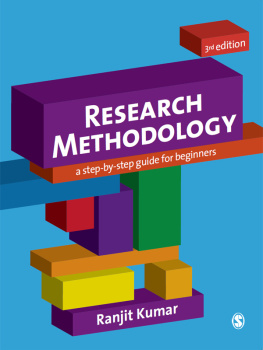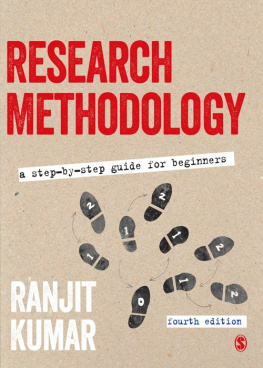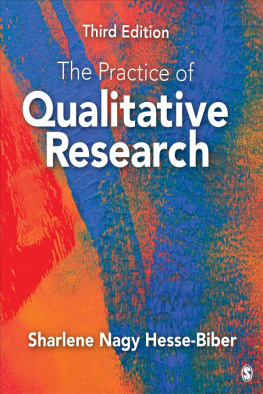RESEARCH METHODOLOGY
a step-by-step guide for beginners
SAGE has been part of the global academic community since 1965, supporting high quality research and learning that transforms society and our understanding of individuals, groups, and cultures. SAGE is the independent, innovative, natural home for authors, editors and societies who share our commitment and passion for the social sciences.
Find out more at: www.sagepublications.com

3rd edition
RESEARCH METHODOLOGY
a step-by-step guide for beginners
Ranjit Kumar

Ranjit Kumar 1999, 2005, 2011
First edition published 1999
Second edition published 2005. Reprinted 2007, 2008 (twice), 2009 (twice)
This third edition published 2011
Apart from any fair dealing for the purposes of research or private study, or criticism or review, as permitted under the Copyright, Designs and Patents Act, 1988, this publication may be reproduced, stored or transmitted in any form, or by any means, only with the prior permission in writing of the publishers, or in the case of reprographic reproduction, in accordance with the terms of licences issued by the Copyright Licensing Agency. Enquiries concerning reproduction outside those terms should be sent to the publishers.
SAGE Publications Ltd
1 Olivers Yard
55 City Road
London EC1Y 1SP
SAGE Publications Inc.
2455 Teller Road
Thousand Oaks, California 91320
SAGE Publications India Pvt Ltd
B 1/I 1 Mohan Cooperative Industrial Area
Mathura Road
New Delhi 110 044
SAGE Publications Asia-Pacific Pte Ltd
33 Pekin Street #02-01
Far East Square
Singapore 048763
Library of Congress Control Number available
British Library Cataloguing in Publication data
A catalogue record for this book is available from the British Library
ISBN 978-1-84920-300-5
ISBN 978-1-84920-301-2 (pbk)
Typeset by C&M Digitals (P) Ltd, Chennai, India
Printed and bound in Great Britain by TJ International Ltd, Padstow, Cornwall
Printed on paper from sustainable resources

To my daughter, Parul
Contents
Figures
Tables
Preface
This book is based upon my experiences in research as a student, practitioner and teacher. The difficulties I faced in understanding research as a student, my discoveries about what was applicable and inapplicable in the field as a practitioner, and my development of the ability effectively to communicate difficult concepts in simple language without sacrificing technicality and accuracy as a teacher have become the basis of this book.
Research methodology is taught as a supporting subject in several ways in many academic disciplines such as health, education, psychology, social work, nursing, public health, library studies and marketing research. The core philosophical base for this book comes from my conviction that, although these disciplines vary in content, their broad approach to a research enquiry is similar. This book, therefore, is addressed to these academic disciplines.
It is true that some disciplines place greater emphasis on quantitative research and some on qualitative research. My own approach to research is a combination of both. Firstly, it is the objective that should decide whether a study be carried out adopting a qualitative or a quantitative approach. Secondly, in real life most research is a combination of both methods. Though they differ in the philosophy that underpins their mode of enquiry, to a great extent their broad approach to enquiry is similar. The quantitative research process is reasonably well structured whereas the qualitative one is fairly unstructured, and these are their respective strengths as well as weaknesses. I strongly believe that both are important to portray a complete picture. In addition, there are aspects of quantitative research that are qualitative in nature. It depends upon how a piece of information has been collected and analysed. Therefore I feel very strongly that a good researcher needs to have both types of skill. I follow a qualitativequantitativequalitative approach to an enquiry. This book, therefore, has been written to provide theoretical information in an operational manner about methods, procedures and techniques that are used in both approaches.
Research as a subject is taught at different levels. The book is designed specifically for students who are newcomers to research and who may have a psychological barrier with regard to the subject. I have therefore not assumed any previous knowledge on the part of the reader; I have omitted detailed discussion of aspects that may be inappropriate for beginners; I have used many flow charts and examples to communicate concepts; and areas covered in the book follow a simple to complex approach in terms of their discussion and coverage.
The structure of this book, which is based on the model developed during my teaching career, is designed to be practical. The theoretical knowledge that constitutes research methodology is therefore organised around the operational steps that form this research process for both quantitative and qualitative research. All the information needed to take a particular step, during the actual research journey, is provided in one place. The needed information is organised in chapters and each chapter is devoted to a particular aspect of that step (see ). For example, Formulating a research problem is the first operational step in the research process. For formulating a good research problem, in my opinion, you need to know how to review the literature, formulate a research problem, deal with variables and their measurement, and construct hypotheses. Hence, under this step, there are four chapters. The information they provide will enable you to formulate a problem that is researchable. These chapters are titled: Reviewing the literature, Formulating a research problem, Identifying variables and Constructing hypotheses. Similarly, for the operational step, step III, Constructing an instrument for data collection, the chapters titled Selecting a method of data collection, Collecting data using attitudinal scales and Establishing the validity and reliability of a research instrument will provide sufficient information for you to develop an instrument for data collection for your study. For every aspect at each step, a smorgasbord of methods, models, techniques and procedures is provided for both quantitative and qualitative studies in order for you to build your knowledge base in research methodology and also to help you to select the most appropriate ones when undertaking your own research.
It is my belief that a sound knowledge of research methodology is essential for undertaking a valid study. To answer your research questions, up to Step V, Writing a research proposal, knowledge of research methods is crucial as this enables you to develop a conceptual framework which is sound and has merits for undertaking your research endeavour with confidence. Having completed the preparatory work, the steps that follow are more practical in nature, the quality of which entirely depends upon the soundness of the methodology you proposed in your research proposal. Statistics and computers play a significant role in research but their application is mainly after the data has been collected. To me, statistics are useful in confirming or contradicting conclusions drawn from simply looking at analysed data, in providing an indication of the magnitude of the relationship between two or more variables under study, in helping to establish causality, and in ascertaining the level of confidence that can be placed in your findings. A computers application is primarily in data analysis, the calculation of statistics, word processing and the graphic presentation of data. It saves time and makes it easier for you to undertake these activities; however, you need to learn this additional skill. This book does not include statistics or information about computers.
Next page

